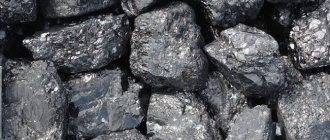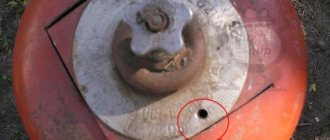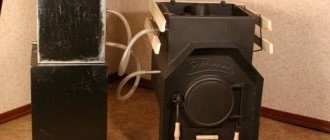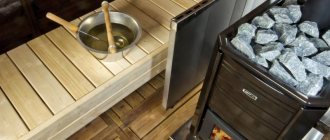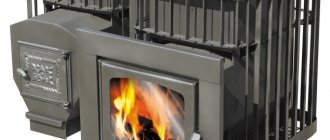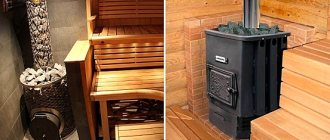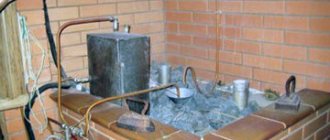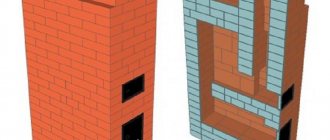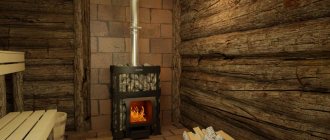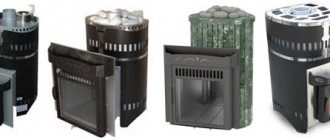Sauna heating with briquettes
The bathhouse is a whole cultural phenomenon that contains many nuances and features. Entire generations of Russians cannot imagine their lives without a bathhouse or sauna. There are many types and methods of building baths, a wide range of materials for finishing the steam room, countless boilers and only the types of fuel remain unchanged. Few. But is this really so? In this article we will look at the features of heating a bathhouse with fuel briquettes made from wood waste.
Pressed chips can give any firewood a run for its money. The most important parameter of any fuel for a boiler or sauna stove is calorific value . It is the indicator that shows how many kilocalories a kilogram of a particular fuel will produce. And here we are faced with the first discovery: fuel briquettes have the highest calorific value! For example, the calorific value of the best dry birch firewood will barely exceed 2500 kcal/kg. This indicator for drill coal is 3900 kcal/kg. At the same time, fuel briquettes have an average calorific value of up to 4500 kcal/kg! To be honest, this is an amazing result, which is not much behind the indicator of black coal, yes, the same coal that is used to heat large power plants.
Fuel briquettes or firewood
Firewood is a traditional heating fuel that has warmed humanity for thousands of years.
A word familiar to millions of people from childhood is associated with the comfort and warmth of their home. And although the annual collection of firewood evokes slightly different associations, because it needs to be bought, sawed and chopped, and more than one cubic meter of firewood will be needed for the winter, wood fuel still remains the most popular heating material. Of course, firewood can hardly be called a non-alternative type of fuel. There is no competition for heating with natural gas, coal is more profitable, and relatively recently, fuel briquettes began to compete with firewood. The following waste is used to produce this modern type of stove material:
- wood processing (shavings, wood chips, wood dust, sawdust, pine needles);
- agriculture (straw, hay, etc.);
- food industry (sunflower husks, grain crops);
- peat, tree leaves, etc.
True, despite the fact that briquettes are produced from waste materials, their price continues to remain at a fairly high level.
Are briquettes suitable for saunas or are they only used for heating a home?
Briquettes are made in special presses by burning and sintering sawdust with a gas-air mixture and further pressing under high pressure. The density of briquettes is three or four times higher than that of the best firewood. The briquette contains much more wood than the tree itself, no matter how strange it may sound.
Fuel briquettes are very versatile and are suitable for all types of stoves and boilers . They are even suitable for barbecues, fireplaces or large industrial boilers. Yes, manufacturers of steel sauna stoves made of steel, so-called heaters, do not recommend using fuel with a calorific value higher than 4900 kcal, and black coal has this value. But that’s the beauty of briquettes, that their calorific value is slightly lower, so even the most “delicate” stoves will digest them perfectly. But we are talking about the firebox of a bathhouse, and here the most important thing is the length of burning or smoldering. In other words, what is important to us is not the speed of heating the room (although briquettes are fine with this), but that the fuel generates heat for as long .
Due to low humidity and high density , fuel briquettes burn and then smolder for a very long time, at least two hours. According to this indicator, they at least twice as good as firewood This means that less European firewood will be required to heat the sauna and maintain heat in the firebox. The firebox can not be filled to its full depth, but only halfway. What else is important for a bath? What is important is the environmental friendliness of the fuel, with which everything is in order. Firstly, briquettes have an ultra-low ash content, it does not exceed 0.8-0.9%. Therefore, after burning a briquette, what remains in the firebox is not a huge pile of ash, but only a small pile of ash, which can be easily removed. Secondly, briquettes emit much less smoke, thereby keeping boilers, fireboxes and chimneys clean for much longer. Linden briquettes are especially good , which is exactly what our company produces. Of all types of wood, linden contains the least amount of resin , so fuel briquettes made from this tree do not pollute fuel systems and chimneys at all. Moreover, the use of linden fuel briquettes reduces the risk of corrosion and contamination of boiler nozzles.
With fuel briquettes, the black sauna opens up in a completely new way. There is minimal smoke and no suffocating tars either. What is there? And there are many phytoncides that heal the body and strengthen the immune system. This is especially noticeable when burning with linden fuel briquettes. The entire bathhouse is filled with the enchanting aromas of flowers and honey, the smells of meadows and fields - just an incredible atmosphere.
Well, a few words about storage. We all know very well what a hassle it is: delivering, unloading and preparing firewood for use. Often you have to work hard with an ax, after which wood chips, bark and other waste remain, spoiling the appearance of the area or bathhouse. With briquettes you are free of such problems, since they are supplied in packs of 10-12 bricks each. The packs are wrapped in a thick film that protects the briquettes from moisture and other aggressive influences. Since briquettes are shaped like bricks, they are very easy to stack, and you can even build entire walls from briquettes. They take up very little space in the bathhouse, look organic and even stylish. And we’re not even talking about ease of storage and use - it’s clear without words.
To summarize: fuel briquettes are an excellent alternative to firewood . An alternative that will save the family budget , save equipment, free up and improve more space. And most importantly, it will help you experience even more pleasure from bathing!
Features of the use of fuel briquettes
The combustion technology is available and will not cause any particular difficulties. It is important to clarify some details, as well as carefully select products. The quality and characteristics of different products differ, so fuel briquettes made from sawdust should not contain foreign impurities. That is why you should not save money by buying products that use waste chipboards, MDF, and similar products. The combustion process will produce a lot of soot, so the chimney will need to be thoroughly cleaned with regular use.
How to use it correctly:
- This type of fuel is used for special boilers, as well as conventional stoves, fireplaces, and heating baths and saunas.
- The firebox is placed in a pre-cleaned firebox; paper is used for ignition.
- Products require special storage conditions where contact with water is minimized. When moisture accumulates, they swell and support the combustion process worse.
- Due to the dense structure, heating of the room occurs more slowly than when burning wood. The temperature is maintained longer; it will need to be added to the firebox less frequently than with firewood.
- In fireplaces it is advisable to use it together with firewood, which produces beautiful flames.
Sawdust in briquettes is glued together using lignin, a natural substance released from raw materials during the pressing process. This requires the use of special equipment, so “handicraft” production involves the addition of binders. This worsens the characteristics of the products, so it is better to buy only certified products.
Fuel briquettes are a great way to save money wisely while providing your home with warmth and comfort. Unlike ordinary firewood, they are characterized by stable combustion, emit less smoke and soot, and burn almost without a trace. The main advantages of this type of fuel, as well as the features of the furnace firebox, are discussed in our review.
How to heat a stove with fuel briquettes, how to light them
Recently, the trend of returning to old traditions, at least in the domestic sphere, has become increasingly clear. Every owner wants to have a stove or fireplace in his home, which he identifies with the hearth. The warmth, coziness and comfort that stoves and fireplaces can give us are incomparable to anything else. In addition, private homes often already have a heating system, so a stove or fireplace is more of a decorative tool designed to bring peace, tranquility and joy.
To light a stove or fireplace, we can use ordinary firewood, or we can resort to innovative fuel. In this article we would like to talk about how to heat a stove with fuel briquettes, a modern alternative to classic firewood.
Kindling the bath
Eurobriquettes are a universal fuel; they can be used to heat all types of stoves and boilers. They can be used in outdoor grills and home fireplaces. At the same time, the consumption of fuel briquettes is always significantly less than conventional firewood.
Many people are interested in whether it is possible to heat a stove with fuel briquettes if it is made of steel, like an ordinary heater? This question is quite logical, since such stoves have restrictions on the calorific value of the fuel; you cannot heat a steel sauna stove with black coal, which emits 4900 kcal/kg of heat. But in the case of Eurobriquettes, less heat is released, which means they can be used to heat a stove in a bathhouse.
For a bathhouse, not only the heat generated is important, but also the duration of burning of wood or alternative fuel. The longer the wood burns with maximum heat release, the better it is for the sauna stove and the sauna itself.
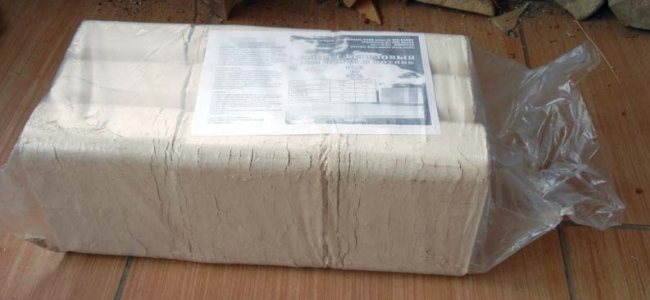
Lighting fuel briquettes is not very easy, the fire does not catch immediately, but after they light up, they will burn and smolder for a couple of hours, which is much longer than the combustion of ordinary firewood. Such a long combustion time of fuel briquettes is explained by their high density and low humidity.
The large amount of heat generated and the long burnout time indicate that the consumption of fuel briquettes for heating a house is much less than that required for ordinary firewood.
Let us note that, according to people’s reviews, you should not completely fill the firebox of a sauna stove with Euro-wood, so as not to quickly reach the maximum heat transfer values.
An interesting point with Eurobriquettes is the residues left after their combustion. Having increased density characteristics, this fuel burns almost completely; it does not leave a large amount of ash, only a small pile of ash. Ash from fuel blocks smells unpleasant, but is an excellent fertilizer.
When Eurobriquettes burn, virtually no smoke is emitted, which is very valuable for maintaining the cleanliness of fireboxes, boilers, and chimneys. According to experts, linden fuel briquettes contain the least amount of resin, so when using such fuel, chimneys and boiler nozzles suffer the least.
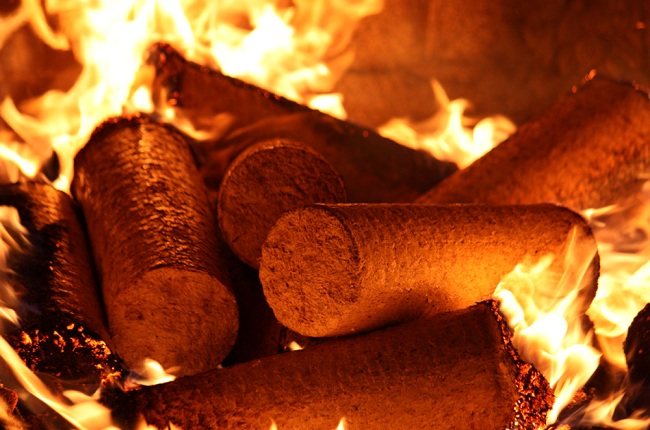
Fuel briquettes are an excellent option for lighting a black sauna. As we have already said, this fuel is environmentally friendly, does not emit smoke, provides enough heat, and phytoncides appear in the heated air, which have a beneficial effect on the human body and improve immunity. Using the same linden eurobriquettes, you will feel how your body is healing, inhaling the pleasant aromas of flowers, honey and trees.
Of course, there is also a drawback to this type of fuel - it cannot quickly generate a lot of heat, it releases it gradually. As we have already said, the combustion is uniform, which, unlike firewood that flares up quickly and quickly dies out, allows you to easily maintain the same temperature.
Advantages of fuel briquettes
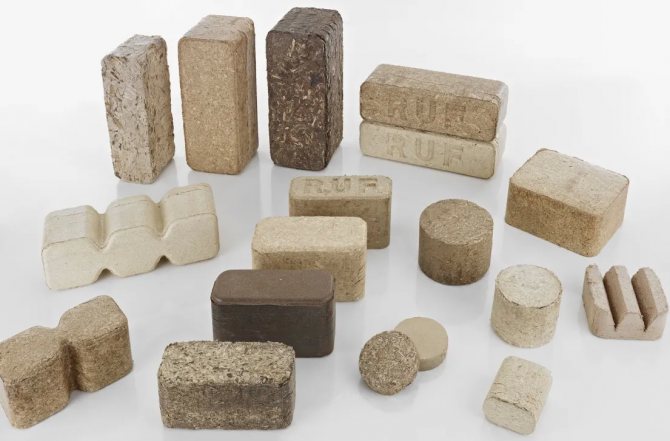
Burning fuel briquettes does not harm health, since they do not contain chemicals.
Fuel briquettes (euro firewood) are bricks made from compressed plant waste: sawdust, shavings, straw, grain husks, stems, etc. Particles of materials are connected to each other under pressure using organic glue (or do without it at all, if there is enough raw material own resins).
Without a doubt, the production of fuel briquettes contributes to a more efficient use of natural resources. But Eurowood has a lot of other advantages:
- They have a heat transfer rate twice as high as firewood (up to 5000 kcal/kg), while the heating power does not decrease during the combustion process. Such heat indicators are achieved due to the high density and low humidity of the products (for briquettes the latter figure is 5–8%, for firewood it reaches 20%).
- They burn out very slowly (about 4 times longer than firewood), which makes it possible to significantly reduce the amount of fuel consumed during the season.
- Does not form soot on the walls of the chimney.
- They burn almost completely, simplifying the cleaning process.
- They burn smoothly and softly: they do not spark, do not make noise, almost do not smoke, do not shoot embers, do not give off a smell, do not emit harmful substances. In other words, they do not create discomfort for people who are close to the flame.
- They are compactly stored in neat stacks, in which they are supplied. Euro firewood does not need to be split, stored in woodpiles, and there is no waste left behind.
The cost of briquettes is 2–3 times higher than firewood, but the difference in price is compensated by their low consumption. In addition, wood is much bulkier and therefore requires additional delivery costs.
House heating
Fuel briquettes are probably ideal for heating a home. The ability to light the stove once and maintain the fire and heat for a long time without additional tossing allows us to talk about the good characteristics of Eurobriquettes. Let's look at how to heat a brick stove with fuel briquettes within the house.
Of course, pressed bricks will not burn immediately, so let’s figure out how to light fuel briquettes. This is quite simple to do; first of all, you should put tree bark, wood chips, and some dry newspapers in the oven, and then place alternative firewood on top. During kindling, while the wood chips are actively igniting, we adjust the airflow. As soon as the fire starts on the first briquettes, you can add the rest.
Another option is to heat the stove with fuel briquettes after the first batch of wood has burned and decent coals have appeared. In such a firebox, the fire can quickly be caught on Eurobriquettes.
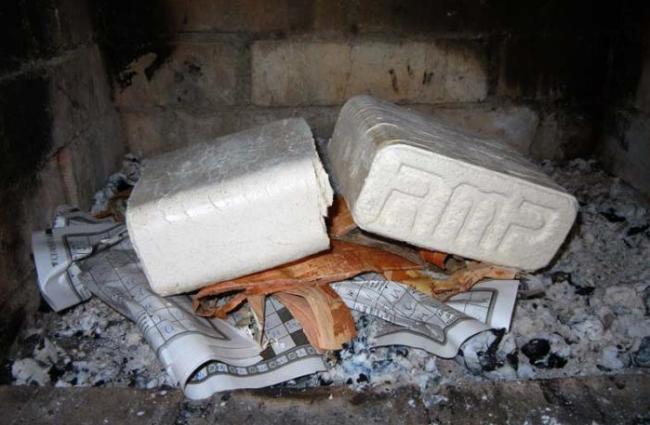
Depending on your needs, we choose the tactics for filling the stove with fuel:
- If you stack the fuel briquettes loosely, at a short distance from each other, the fire in the stove will be quite intense and will generate a lot of heat, which will allow you to quickly heat the house.
- If you stack alternative firewood tightly to each other and cover the vent, the firewood will smolder for a longer time, which is perfect for heating a house at night. At the same time, the consumption of fuel briquettes per day will be several times less than firewood.
In order to roughly understand how many eurobriquettes will be required to heat a house, you should conduct several experiments, each time finding out this parameter in practice. There are too many nuances in this matter.
It is worth noting that fuel briquettes have a specific purpose - to create heat, while firewood can be considered for the purpose of creating a comfortable and cozy environment. For example, is it possible to light a fireplace with fuel briquettes - well, of course, yes, but they will not create the same atmosphere as firewood with its pleasant crackling and uneven fire. By the way, the smell from burning wood is stronger and more pleasant.
fuel briquettes
Good evening, please enlighten me if anyone uses fuel briquettes, what is their advantage over dry birch firewood? I have an idea to use them in a bathhouse, otherwise you would firstly heat the dirt with firewood all the time, and secondly constantly throw it in, you throw a lot into the steam room, you throw a little, they burn out in a moment, you want uniform heat transfer and long burning, is there a benefit if you use briquettes?
Excuse me, but what kind of bathhouse do you have that you have to constantly add firewood to?
I tried it, I didn’t like it, it doesn’t raise the required temperature compared to dry birch. And what is the dirt from?!
A box for firewood, brushes, a broom, even if something spilled on the firebox sheet, 5 seconds and it’s clean.
Good evening, please enlighten me if anyone uses fuel briquettes, what is their advantage over dry birch firewood?
1. you have some kind of garbage with your bathhouse, briquettes won’t help here 2. briquettes are a good thing for two IMHO reasons: they are dry (if stored in a package) and their calorific value is higher than that of firewood.
There is only one drawback - for example, you can’t find them at a normal price.
Dmitry 76
I want uniform heat transfer and long burning
But in general, we need to start with the question: what kind of oven is it?
Papic
There is only one drawback - for example, you can’t find them at a normal price.
I honestly don’t know who uses them.
Their calorific value is higher than that of firewood.
the bathhouse cannot cool down so quickly
Lesnik 61
If the stove is made of a tin, like Thermofor ones, it heats while it burns.
Lesnik 61
If the stove is made of a tin, like Thermofor ones, it heats while it burns.
If the stove is made of a tin, like Thermofor ones, it heats while it burns.
Maxim V
Fuel briquettes are pressed wood sawdust (we consider peat ones - they produce dirt - like from a cement plant). Pressed sawdust can give a greater heat of combustion - than pure firewood - only in one case - if they are impregnated with nitroglycerin. It will be very warm, even hot. but not for long.
No, briquettes do provide a greater calorific value, but this is only like pellets (the same sawdust) - due to lower humidity compared to firewood. By the way, they absorb water perfectly, so they need to be stored in polyethylene. I tried to use it in a boiler - they burn a little longer than birch firewood, but it really depends on the design of the briquette - sometimes they fall apart and burn out quickly.
DIZZI
What's stopping you from adding more? I have a similar oven, only homemade, it’s very convenient, you can adjust the temperature during the process. It’s too hot, don’t add it, the steam has gone, add it. While I’m sipping kvass beer in the dressing room, you see it’s already 10-15 degrees. I usually heat it in the region of 80-85 and then as it goes, if you want, you can heat it up to 110. And firewood is used wisely.
Maxim V
What about the heater? What about the walls? What about the water tank? And then - what kind of stove is this - the wood in which burns out in 15 minutes? Any modern iron sauna stove will heat for at least 2.5 hours - if the sauna is normally heated to 80 degrees, and then an armful of ANY firewood is placed in the stove - then the sauna will be very hot for at least 3-4 hours. And in 3 hours you can wash yourself to death.
I think coal would be longer and hotter. But does it make sense? Again, the smell of wood is more pleasant, even if there was a smoky smell when the door was open.
I think coal would be longer and hotter
Right now I’m heating a bathhouse with a metal stove. Ehh, it’s beautiful outside right now, the snow is slowly falling and the bathhouse is heating up. Vulcan 12 brand stove with 100kg heater, sandwich pipe, chopped sauna. It heats up for 45 minutes, and then you can steam, but after half an hour, add more firewood)).
I use it. The stove takes longer to heat and provides a lot of heat, at least compared to the firewood I used (half-raw). Well, it’s convenient. By the way, briquettes come in different varieties, and the wood used for them varies from manufacturer to manufacturer.
I heat until the water heats up.. It all depends on the design of the stove. I have a type of samovar, it takes 1.5 hours to heat to hot water in the summer now 2-3..
I used peat briquettes in severe frosts to prevent them from freezing, I threw in 2-3 pieces in the morning and evening.. and they generate a lot of dust..
The firewood I use is random elm and oak.
This is the benefit of a classic stove: of course, it takes a long time to heat, but you can use anything
